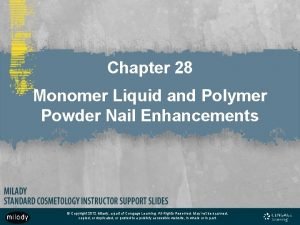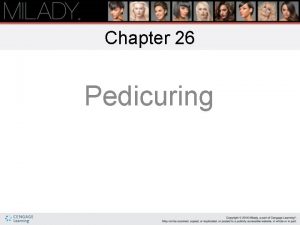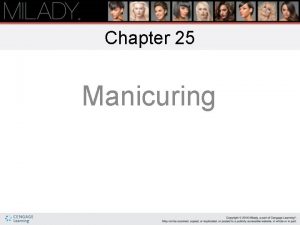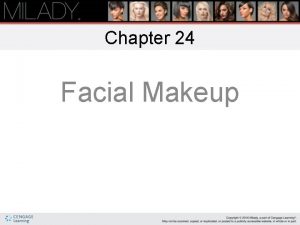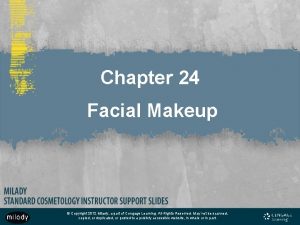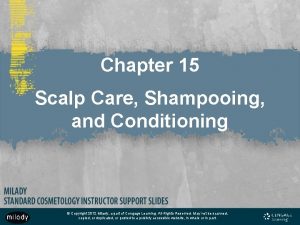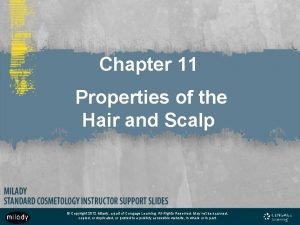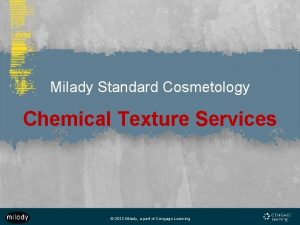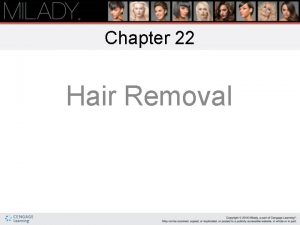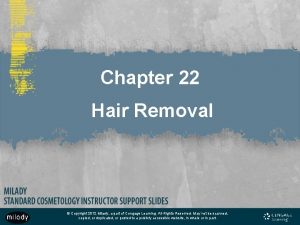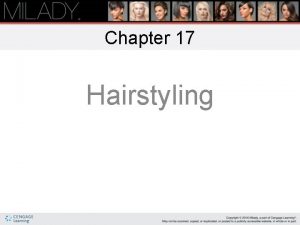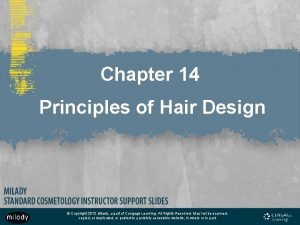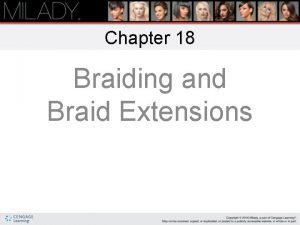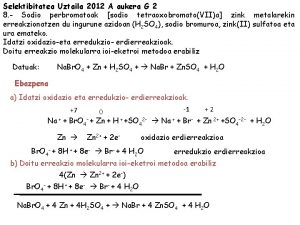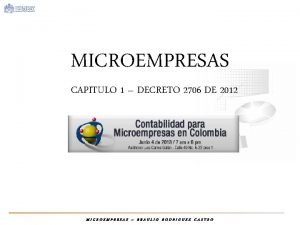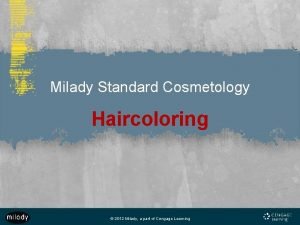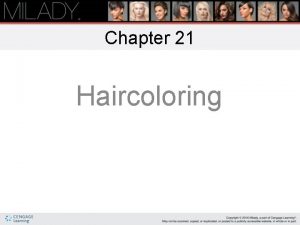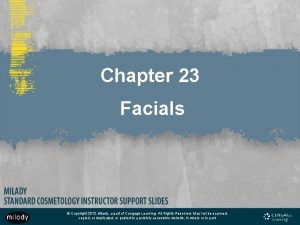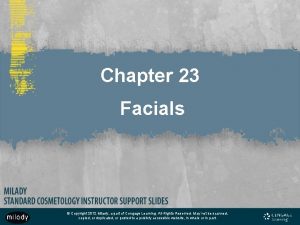Chapter 21 Haircoloring Copyright 2012 Milady a part


































































































- Slides: 98

Chapter 21 Haircoloring © Copyright 2012 Milady, a part of Cengage Learning. All Rights Reserved. May not be scanned, copied, or duplicated, or posted to a publicly accessible website, in whole or in part.

“The only thing that makes life possible is permanent, intolerable uncertainty: not knowing what comes next. ” – Ursula K. Le Guin © Copyright 2012 Milady, a part of Cengage Learning. All Rights Reserved. May not be scanned, copied, or duplicated, or posted to a publicly accessible website, in whole or in part.

Objectives • List the reasons people color their hair. • Explain how the hair’s porosity affects haircolor. • Understand the types of melanin found in hair. • Define and identify levels and their role in formulating haircolor. © Copyright 2012 Milady, a part of Cengage Learning. All Rights Reserved. May not be scanned, copied, or duplicated, or posted to a publicly accessible website, in whole or in part.

Objectives (continued) • Identify primary, secondary, and tertiary colors. • Know what role tone and intensity play in haircolor. • List and describe the categories of haircolor. © Copyright 2012 Milady, a part of Cengage Learning. All Rights Reserved. May not be scanned, copied, or duplicated, or posted to a publicly accessible website, in whole or in part.

Objectives (continued) • Explain the role of hydrogen peroxide in a haircolor formula. • Explain the action of hair lighteners. • List the four key questions to ask when formulating a haircolor. • Understand why a patch test is useful in haircoloring. © Copyright 2012 Milady, a part of Cengage Learning. All Rights Reserved. May not be scanned, copied, or duplicated, or posted to a publicly accessible website, in whole or in part.

Objectives (continued) • Define what a preliminary strand test is and explain why it is used. • List and describe the procedure for a virgin singleprocess color service. • Understand the two processes involved in doubleprocess haircoloring. • Describe the various forms of hair lightener. © Copyright 2012 Milady, a part of Cengage Learning. All Rights Reserved. May not be scanned, copied, or duplicated, or posted to a publicly accessible website, in whole or in part.

Objectives (continued) • Understand the purpose and use of toners. • Name and describe three common methods for highlighting. • Know how to properly cover gray hair. • Know the rules of color correction. • Know the safety precautions to follow during haircoloring. © Copyright 2012 Milady, a part of Cengage Learning. All Rights Reserved. May not be scanned, copied, or duplicated, or posted to a publicly accessible website, in whole or in part.

Haircolor vs. Hair color • Haircolor: a professional, industry-coined term referring to products and services for artificially coloring the hair • Hair color: refers to the natural color of the hair © Copyright 2012 Milady, a part of Cengage Learning. All Rights Reserved. May not be scanned, copied, or duplicated, or posted to a publicly accessible website, in whole or in part.

Reasons for Coloring Hair • Cover up or blend gray hair • Enhance existing hair color • Create a fashion statement or statement of self expression • Correct unwanted tones • Accentuate a particular haircut © Copyright 2012 Milady, a part of Cengage Learning. All Rights Reserved. May not be scanned, copied, or duplicated, or posted to a publicly accessible website, in whole or in part.

Hair Facts • The hair structure affects the quality and ultimate success of the haircolor service. • The structure of the hair and the desired results determine which haircolor product to use. © Copyright 2012 Milady, a part of Cengage Learning. All Rights Reserved. May not be scanned, copied, or duplicated, or posted to a publicly accessible website, in whole or in part.

Hair Structure • Cuticle: outermost layer that contributes 20 percent of overall strength • Cortex: middle layer that contributes 80 percent of overall strength • Medulla: innermost layer (sometimes absent) © Copyright 2012 Milady, a part of Cengage Learning. All Rights Reserved. May not be scanned, copied, or duplicated, or posted to a publicly accessible website, in whole or in part.

Texture • Coarse: large hair-strand diameter. • Medium: medium hair-strand diameter. • Fine: small hair-strand diameter. © Copyright 2012 Milady, a part of Cengage Learning. All Rights Reserved. May not be scanned, copied, or duplicated, or posted to a publicly accessible website, in whole or in part.

Density • Number of hairs per square inch • Refers to hair thickness © Copyright 2012 Milady, a part of Cengage Learning. All Rights Reserved. May not be scanned, copied, or duplicated, or posted to a publicly accessible website, in whole or in part.

Porosity • The ability of the hair to absorb moisture – Porous hair accepts haircolor faster and permits a darker color than less-porous hair. © Copyright 2012 Milady, a part of Cengage Learning. All Rights Reserved. May not be scanned, copied, or duplicated, or posted to a publicly accessible website, in whole or in part.

Types of Porosity • Low porosity – tight cuticle, resistant hair • Average porosity – cuticle slightly raised; average time • High porosity – cuticle lifted; quicker processing time • Test for porosity – finger and thumb test © Copyright 2012 Milady, a part of Cengage Learning. All Rights Reserved. May not be scanned, copied, or duplicated, or posted to a publicly accessible website, in whole or in part.

Natural Hair Color • Melanin in the cortex – Eumelanin: gives black and brown color – Pheomelanin: gives blond and red colors – Mixed melanin: contains both eumelanin and pheomelanin – Contributing pigment: also known as undertone © Copyright 2012 Milady, a part of Cengage Learning. All Rights Reserved. May not be scanned, copied, or duplicated, or posted to a publicly accessible website, in whole or in part.

Level System • Unit of measurement • Identifies lightness or darkness • Arranged on scale of 1 to 10 – 1 being darkest – 10 being lightest © Copyright 2012 Milady, a part of Cengage Learning. All Rights Reserved. May not be scanned, copied, or duplicated, or posted to a publicly accessible website, in whole or in part.

Identifying Natural Level • Take section in crown area. • Match swatches. • Compare strand to determine level. © Copyright 2012 Milady, a part of Cengage Learning. All Rights Reserved. May not be scanned, copied, or duplicated, or posted to a publicly accessible website, in whole or in part.

Gray Hair • The loss of pigment increases with age. Most people retain a certain percentage of pigmented hair. Gray hair can be solid or blended and requires special attention during haircoloring. © Copyright 2012 Milady, a part of Cengage Learning. All Rights Reserved. May not be scanned, copied, or duplicated, or posted to a publicly accessible website, in whole or in part.

Determining Percentage of Gray Hair © Copyright 2012 Milady, a part of Cengage Learning. All Rights Reserved. May not be scanned, copied, or duplicated, or posted to a publicly accessible website, in whole or in part.

Color Theory • Color is the property of objects that depends on the light they reflect. It is perceived as red, green, blue, or other shades. • Base color is the predominant tone of a color. © Copyright 2012 Milady, a part of Cengage Learning. All Rights Reserved. May not be scanned, copied, or duplicated, or posted to a publicly accessible website, in whole or in part.

Law of Color • A system for understanding color relationships. When combining colors, you will always get the same result from the same combination. – Equal parts of red and blue make violet. – Equal parts of blue and yellow make green. – Equal parts of red and yellow make orange. © Copyright 2012 Milady, a part of Cengage Learning. All Rights Reserved. May not be scanned, copied, or duplicated, or posted to a publicly accessible website, in whole or in part.

Primary Colors • Blue • Red • Yellow © Copyright 2012 Milady, a part of Cengage Learning. All Rights Reserved. May not be scanned, copied, or duplicated, or posted to a publicly accessible website, in whole or in part.

Secondary Colors • Green • Orange • Violet © Copyright 2012 Milady, a part of Cengage Learning. All Rights Reserved. May not be scanned, copied, or duplicated, or posted to a publicly accessible website, in whole or in part.

Tertiary Colors • Blue-green • Blue-violet • Red-orange • Yellow-green © Copyright 2012 Milady, a part of Cengage Learning. All Rights Reserved. May not be scanned, copied, or duplicated, or posted to a publicly accessible website, in whole or in part.

Complementary Colors • Blue and orange • Red and green • Yellow and violet © Copyright 2012 Milady, a part of Cengage Learning. All Rights Reserved. May not be scanned, copied, or duplicated, or posted to a publicly accessible website, in whole or in part.

Tone or Hue • Tone or hue: balance of color – Warm: golden, orange, red, yellow – Cool: blue, green, violet • Intensity: strength of color tone © Copyright 2012 Milady, a part of Cengage Learning. All Rights Reserved. May not be scanned, copied, or duplicated, or posted to a publicly accessible website, in whole or in part.

Categories of Haircolor © Copyright 2012 Milady, a part of Cengage Learning. All Rights Reserved. May not be scanned, copied, or duplicated, or posted to a publicly accessible website, in whole or in part.

Temporary Color • Does not penetrate cuticle layer • Coats hair shaft • Neutralizes unwanted tones • Available in variety of colors and products © Copyright 2012 Milady, a part of Cengage Learning. All Rights Reserved. May not be scanned, copied, or duplicated, or posted to a publicly accessible website, in whole or in part.

Traditional Semipermanent • Lasts through several shampoos • Penetrates hair shaft; stains cuticle layer • Fades with each shampoo • Non-oxidation • Used out of bottle; requires patch test © Copyright 2012 Milady, a part of Cengage Learning. All Rights Reserved. May not be scanned, copied, or duplicated, or posted to a publicly accessible website, in whole or in part.

Demipermanents • Deposits color; does not lift • Requires high p. H for decolorization • Ideal for: – Introducing hair color services – Blending or covering gray – Refresh faded color – Color corrections © Copyright 2012 Milady, a part of Cengage Learning. All Rights Reserved. May not be scanned, copied, or duplicated, or posted to a publicly accessible website, in whole or in part.

Permanent Haircolor • Used to match and lighten hair, and to cover gray hair • Contains ammonia, oxidative tints, and peroxide • Contains aniline derivatives • Combine with H 2 O 2 to form larger molecules • Removes natural pigment while adding artificial color • Best to cover gray © Copyright 2012 Milady, a part of Cengage Learning. All Rights Reserved. May not be scanned, copied, or duplicated, or posted to a publicly accessible website, in whole or in part.

Permanent Haircolor Action © Copyright 2012 Milady, a part of Cengage Learning. All Rights Reserved. May not be scanned, copied, or duplicated, or posted to a publicly accessible website, in whole or in part.

Gradual Haircolor • Gradual haircolors, also known as metallic haircolors, contain metal salts that change hair color gradually by progressive buildup and exposure to air, creating a dull, metallic appearance. © Copyright 2012 Milady, a part of Cengage Learning. All Rights Reserved. May not be scanned, copied, or duplicated, or posted to a publicly accessible website, in whole or in part.

Natural Haircolor • From leaves or bark of plants • No lightening • Limited shade range • Professional products cannot be applied over © Copyright 2012 Milady, a part of Cengage Learning. All Rights Reserved. May not be scanned, copied, or duplicated, or posted to a publicly accessible website, in whole or in part.

Hydrogen Peroxide Developers • Oxidizing agents or catalysts • p. H between 2. 5 and 4. 5 • H 2 O 2 most common • Volume – Lower volume, less lift – Higher volume, greater lift © Copyright 2012 Milady, a part of Cengage Learning. All Rights Reserved. May not be scanned, copied, or duplicated, or posted to a publicly accessible website, in whole or in part.

Hydrogen Peroxide Volume and Uses © Copyright 2012 Milady, a part of Cengage Learning. All Rights Reserved. May not be scanned, copied, or duplicated, or posted to a publicly accessible website, in whole or in part.

Lighteners • Lighten prior to color application • Lighten to a desired shade • Lighten and brighten existing shade • Lighten only certain parts of hair • Lighten dark natural or color-treated levels © Copyright 2012 Milady, a part of Cengage Learning. All Rights Reserved. May not be scanned, copied, or duplicated, or posted to a publicly accessible website, in whole or in part.

The Ten Degrees of Natural Hair Decolorization © Copyright 2012 Milady, a part of Cengage Learning. All Rights Reserved. May not be scanned, copied, or duplicated, or posted to a publicly accessible website, in whole or in part.

Contributing Pigment • Decolorize to appropriate level. • Apply new color. © Copyright 2012 Milady, a part of Cengage Learning. All Rights Reserved. May not be scanned, copied, or duplicated, or posted to a publicly accessible website, in whole or in part.

Toners • Traditional semipermanent, demipermanent, and permanent haircolor products that are used primarily on prelightened hair to achieve pale and delicate colors © Copyright 2012 Milady, a part of Cengage Learning. All Rights Reserved. May not be scanned, copied, or duplicated, or posted to a publicly accessible website, in whole or in part.

Lifting Past Pale Yellow • Hair will become mushy. • Hair will lose elasticity. • Hair will be harsh and brittle when dry. • Hair will often suffer breakage. • Hair will often not accept toner. © Copyright 2012 Milady, a part of Cengage Learning. All Rights Reserved. May not be scanned, copied, or duplicated, or posted to a publicly accessible website, in whole or in part.

Consultation • Book 15 minutes of additional time. • Have client fill out record card. • Conduct in proper lighting. • Look at client directly. • Recommend two options. • Be honest. © Copyright 2012 Milady, a part of Cengage Learning. All Rights Reserved. May not be scanned, copied, or duplicated, or posted to a publicly accessible website, in whole or in part.

Consultation (continued) • Gain approval from client. • Start haircolor service. • Educate client regarding home-care maintenance. • Complete record card. © Copyright 2012 Milady, a part of Cengage Learning. All Rights Reserved. May not be scanned, copied, or duplicated, or posted to a publicly accessible website, in whole or in part.

Client Service Record Card © Copyright 2012 Milady, a part of Cengage Learning. All Rights Reserved. May not be scanned, copied, or duplicated, or posted to a publicly accessible website, in whole or in part.

Release Statement © Copyright 2012 Milady, a part of Cengage Learning. All Rights Reserved. May not be scanned, copied, or duplicated, or posted to a publicly accessible website, in whole or in part.

Four Basic Questions • What is natural level? • What are desired level and tone? • Are contributing pigments revealed? • What colors should be mixed? © Copyright 2012 Milady, a part of Cengage Learning. All Rights Reserved. May not be scanned, copied, or duplicated, or posted to a publicly accessible website, in whole or in part.

Deposit and Lifting Ability • The combination of the shade selected and the volume of hydrogen peroxide determines the deposit and lifting ability of a haircolor. © Copyright 2012 Milady, a part of Cengage Learning. All Rights Reserved. May not be scanned, copied, or duplicated, or posted to a publicly accessible website, in whole or in part.

Mixing Permanent Haircolor • Applicator bottle: Bottle must be large enough for color and developer; mix according to manufacturer’s directions. • Brush and bowl: Use nonmetallic bowl. Pour developer first, then product; blend thoroughly. © Copyright 2012 Milady, a part of Cengage Learning. All Rights Reserved. May not be scanned, copied, or duplicated, or posted to a publicly accessible website, in whole or in part.

Double-Process Haircolor • Hair Lightening – bleaching or decolorizing. • Double-process high-lift coloring – two step blonding. • Prelightening – applied the same as hair lightening. © Copyright 2012 Milady, a part of Cengage Learning. All Rights Reserved. May not be scanned, copied, or duplicated, or posted to a publicly accessible website, in whole or in part.

Three Types of Lighteners • Oil – On-the-scalp lightener • Cream – On-the-scalp lightener • Powder – Off-the-scalp lightener • Activators: increase lightening ability © Copyright 2012 Milady, a part of Cengage Learning. All Rights Reserved. May not be scanned, copied, or duplicated, or posted to a publicly accessible website, in whole or in part.

On-the-Scalp Lighteners • Mildest • Appropriate for one to two levels of lift • Give some protection to hair and scalp • More control from thickeners • Help prevent overlapping © Copyright 2012 Milady, a part of Cengage Learning. All Rights Reserved. May not be scanned, copied, or duplicated, or posted to a publicly accessible website, in whole or in part.

Powdered Off-the-Scalp Lighteners • Not applied to scalp • Strong enough for blonding • Called quick lighteners • Contain oxygen-releasing boosters • Dry out more quickly than other lighteners • Expand spread out during processing © Copyright 2012 Milady, a part of Cengage Learning. All Rights Reserved. May not be scanned, copied, or duplicated, or posted to a publicly accessible website, in whole or in part.

Time Factors for Processing • Darker hair has more melanin and takes longer to lighten. • Porosity influences timing. • Tone influences timing. • Strength of product influences timing. • Heat leads to quicker lightening. © Copyright 2012 Milady, a part of Cengage Learning. All Rights Reserved. May not be scanned, copied, or duplicated, or posted to a publicly accessible website, in whole or in part.

Preliminary Strand Test • Watch for discoloration or breakage. • Reconditioning may be required. • Increased strength or processing time may be required. • Patch test is required 24 to 48 hours in advance of application. © Copyright 2012 Milady, a part of Cengage Learning. All Rights Reserved. May not be scanned, copied, or duplicated, or posted to a publicly accessible website, in whole or in part.

Lightener Retouch and Using Toners • Lighten new growth first. • Proceed as for virgin lightener, except apply product to new growth only. © Copyright 2012 Milady, a part of Cengage Learning. All Rights Reserved. May not be scanned, copied, or duplicated, or posted to a publicly accessible website, in whole or in part.

Highlighting • Color some strands lighter than natural color • Adds variety of lighter shades and illusion of depth • Does not contrast strongly with natural color • Light colors cause the light to advance toward the eye, to appear larger, and to make details more visible. © Copyright 2012 Milady, a part of Cengage Learning. All Rights Reserved. May not be scanned, copied, or duplicated, or posted to a publicly accessible website, in whole or in part.

Reverse Highlighting • Called lowlighting • Some strands colored darker than natural • Receding, smaller appearance of dark areas © Copyright 2012 Milady, a part of Cengage Learning. All Rights Reserved. May not be scanned, copied, or duplicated, or posted to a publicly accessible website, in whole or in part.

Cap Technique • This technique involves pulling clean strands of hair through a perforated cap with a thin plastic or metal hook. The number of strands pulled through the cap determines the degree of highlighting achieved. © Copyright 2012 Milady, a part of Cengage Learning. All Rights Reserved. May not be scanned, copied, or duplicated, or posted to a publicly accessible website, in whole or in part.

Cap Strategies • Lighten with powder (off-the-scalp) lightener. • Begin in most resistant area. • Cover while processing. • Rinse thoroughly and shampoo. • Towel-blot and condition. • Tone if desired. © Copyright 2012 Milady, a part of Cengage Learning. All Rights Reserved. May not be scanned, copied, or duplicated, or posted to a publicly accessible website, in whole or in part.

Cap Technique © Copyright 2012 Milady, a part of Cengage Learning. All Rights Reserved. May not be scanned, copied, or duplicated, or posted to a publicly accessible website, in whole or in part.

Foil Technique • This technique involves coloring selected strands by slicing or weaving out sections, placing them on foil or plastic wrap, applying lightener or permanent haircolor, and sealing them in the wrap. © Copyright 2012 Milady, a part of Cengage Learning. All Rights Reserved. May not be scanned, copied, or duplicated, or posted to a publicly accessible website, in whole or in part.

Foil Technique (continued) • Slicing: involves making a straight part at scalp, positioning a narrow 1/8 -inch section of hair over foil, and applying lightener or color © Copyright 2012 Milady, a part of Cengage Learning. All Rights Reserved. May not be scanned, copied, or duplicated, or posted to a publicly accessible website, in whole or in part.

Foil Technique (continued) • Weaving: involves selecting strands that are picked up using a zigzag motion of the comb © Copyright 2012 Milady, a part of Cengage Learning. All Rights Reserved. May not be scanned, copied, or duplicated, or posted to a publicly accessible website, in whole or in part.

Baliage • Baliage: involves painting product onto clean, styled hair; also known as the free-form technique © Copyright 2012 Milady, a part of Cengage Learning. All Rights Reserved. May not be scanned, copied, or duplicated, or posted to a publicly accessible website, in whole or in part.

Toning Highlighted and Dimensionally Colored Hair • Decolorize to desired level. • Consider porosity and pigmentation. • Avoid affecting untreated hair. – Use nonoxidative toner. – Use traditional semipermanent color. – Use no-lift, deposit-only demipermanent color that will not cause additional lightening. © Copyright 2012 Milady, a part of Cengage Learning. All Rights Reserved. May not be scanned, copied, or duplicated, or posted to a publicly accessible website, in whole or in part.

Highlighting Shampoos • Used when slight change in color is desired • Used when hair processes rapidly • Used to highlight natural color in a single application © Copyright 2012 Milady, a part of Cengage Learning. All Rights Reserved. May not be scanned, copied, or duplicated, or posted to a publicly accessible website, in whole or in part.

Gray Hair Challenges • Gray hair can turn orange if lightener is not processed long enough. © Copyright 2012 Milady, a part of Cengage Learning. All Rights Reserved. May not be scanned, copied, or duplicated, or posted to a publicly accessible website, in whole or in part.

Yellow Discoloration Causes • Smoking • Medication • Sun exposure • Some styling aids © Copyright 2012 Milady, a part of Cengage Learning. All Rights Reserved. May not be scanned, copied, or duplicated, or posted to a publicly accessible website, in whole or in part.

Formulating for Gray Hair • Level 9 or lighter may not give complete coverage. • Level 7 or darker can be used to create pastel and blond tones. • For 80 percent to 100 percent natural gray, blond is more flattering than darker tones. • When coloring salt and pepper to darker, color on color will make darker shade. © Copyright 2012 Milady, a part of Cengage Learning. All Rights Reserved. May not be scanned, copied, or duplicated, or posted to a publicly accessible website, in whole or in part.

Formulating for Gray Hair (continued) © Copyright 2012 Milady, a part of Cengage Learning. All Rights Reserved. May not be scanned, copied, or duplicated, or posted to a publicly accessible website, in whole or in part.

More Gray Hair Considerations • Client personality • Personal preferences • Amount and location of gray hair © Copyright 2012 Milady, a part of Cengage Learning. All Rights Reserved. May not be scanned, copied, or duplicated, or posted to a publicly accessible website, in whole or in part.

Tips for Gray Coverage • Use 20 volume developer. • Process color full 45 minutes. • Add neutral to formula. • If 25 percent gray, use 25 percent neutral. • If 50 percent gray, use 50 percent neutral. • If 75 percent gray, use 75 percent neutral. © Copyright 2012 Milady, a part of Cengage Learning. All Rights Reserved. May not be scanned, copied, or duplicated, or posted to a publicly accessible website, in whole or in part.

Presoftening • Apply presoftener to resistant area. • Process 15 minutes. • Refer to manufacturer’s directions. • Blot presoftener off with towel. • Apply final color formula. • Process according to instructions. © Copyright 2012 Milady, a part of Cengage Learning. All Rights Reserved. May not be scanned, copied, or duplicated, or posted to a publicly accessible website, in whole or in part.

Rules for Effective Color Correction • • Do not panic. Determine true problem. Determine cause of problem. Develop a solution. Take one step at a time. Never guarantee results. Always strand-test for accuracy. © Copyright 2012 Milady, a part of Cengage Learning. All Rights Reserved. May not be scanned, copied, or duplicated, or posted to a publicly accessible website, in whole or in part.

Damaged Hair Characteristics • • Rough texture Overporous condition Brittle and dry to touch Susceptible to breakage No elasticity Spongy and matted when wet Color fading or absorbing too rapidly © Copyright 2012 Milady, a part of Cengage Learning. All Rights Reserved. May not be scanned, copied, or duplicated, or posted to a publicly accessible website, in whole or in part.

Damaged Hair Treatments • Use penetrating conditioner. • Normalize p. H with finishing rinse. • Postpone further chemical services. • Perform between-service conditioning. • Recommend retail products for home maintenance. © Copyright 2012 Milady, a part of Cengage Learning. All Rights Reserved. May not be scanned, copied, or duplicated, or posted to a publicly accessible website, in whole or in part.

Fillers • Conditioner fillers: used to recondition damaged, overly porous hair • Color fillers: used to equalize porosity and deposit color in one application © Copyright 2012 Milady, a part of Cengage Learning. All Rights Reserved. May not be scanned, copied, or duplicated, or posted to a publicly accessible website, in whole or in part.

Advantages of Color Fillers • Deposit color to faded ends • Help hair hold color • Prevent streaking and dull appearance • Prevent off-color results • Produce more uniform color when coloring hair back to its natural color © Copyright 2012 Milady, a part of Cengage Learning. All Rights Reserved. May not be scanned, copied, or duplicated, or posted to a publicly accessible website, in whole or in part.

Selecting Correct Color Filler • Select to replace missing primary color. • Apply directly to hair or mix with haircolor and apply to damaged ends. © Copyright 2012 Milady, a part of Cengage Learning. All Rights Reserved. May not be scanned, copied, or duplicated, or posted to a publicly accessible website, in whole or in part.

Tips for Redheads • Use red-orange base to create warm, coppery reds. • Use red-violet for hot, fiery reds. • Use no-lift, deposit-only color to refresh. • If gray is present, add 1/2 to 1 oz of a natural color. • Refresh with a soap cap to brighten color. © Copyright 2012 Milady, a part of Cengage Learning. All Rights Reserved. May not be scanned, copied, or duplicated, or posted to a publicly accessible website, in whole or in part.

Tips for Brunettes • Use cool blue base to avoid brassy tones. • Do not lighten more than two levels above natural color to avoid brassy tones. • Add 1 oz of natural color to cover gray. • Natural highlights should be deep or caramel colored. © Copyright 2012 Milady, a part of Cengage Learning. All Rights Reserved. May not be scanned, copied, or duplicated, or posted to a publicly accessible website, in whole or in part.

Tips for Blonds • Watch out for underlying, unwanted warm tones when lightening from brown to blond. • Use level 7 or darker to cover gray. • Get light pale blond by double-processing. • If using high lift blonds to only 5 levels, results may be warm or brassy. • If highlights become too blond, add lowlights for more natural color. © Copyright 2012 Milady, a part of Cengage Learning. All Rights Reserved. May not be scanned, copied, or duplicated, or posted to a publicly accessible website, in whole or in part.

Common Haircolor Solutions • Refresh faded color: Apply a demipermanent haircolor within two levels of formula and process for up to 10 minutes. • Green cast: Remove buildup and use color to neutralize unwanted color. • Overall color is too light: Apply a no-lift, deposit-only color that is one to two levels darker. • Overall color is too dark: Apply a haircolor remover for 10 minutes and check. © Copyright 2012 Milady, a part of Cengage Learning. All Rights Reserved. May not be scanned, copied, or duplicated, or posted to a publicly accessible website, in whole or in part.

Tips for Restoring Blond to Natural • If level 6, soften new growth with level 6 violet base and 20 volume developer. Process 20 minutes. • If level 7, soften new growth with level 8 light blond-violet base and 20 volume developer. Process 20 minutes. © Copyright 2012 Milady, a part of Cengage Learning. All Rights Reserved. May not be scanned, copied, or duplicated, or posted to a publicly accessible website, in whole or in part.

Tips for Restoring Blond to Natural (continued) • Apply no-lift, deposit-only glaze with 1 oz level 8 light neutral blond and 1 oz level 9 very light blond red-orange base. Process process 20 minutes. • Do not apply to new growth. • Mix a no-lift, deposit-only glaze with 1 -1/2 oz level 6 dark neutral blond and 1/2 oz level 4 light brown gold base. © Copyright 2012 Milady, a part of Cengage Learning. All Rights Reserved. May not be scanned, copied, or duplicated, or posted to a publicly accessible website, in whole or in part.

Tips for Restoring Blond to Natural (continued) • If level 8 light violet blond at base, use 1 -1/2 oz level 8 light neutral blond with 1/2 oz level 6 dark golden blond. • Apply chosen formula, starting where most overlightened. • Work color through all hair. • Process up to 20 minutes, checking every 5 minutes, and then reevaluate. © Copyright 2012 Milady, a part of Cengage Learning. All Rights Reserved. May not be scanned, copied, or duplicated, or posted to a publicly accessible website, in whole or in part.

Safety Precautions • Administer patch test. • Do not apply if abrasions are present. • Do not apply if metallic or compound tint is present. • Do not brush hair prior to service. • Read and follow all manufacturer’s directions. © Copyright 2012 Milady, a part of Cengage Learning. All Rights Reserved. May not be scanned, copied, or duplicated, or posted to a publicly accessible website, in whole or in part.

Safety Precautions (continued) • Use disinfected applicators and tools. • Drape properly. • Perform strand test. • Use glass or plastic bowl or plastic bottle. • Wear protective gloves. • Do not let color get in eyes. © Copyright 2012 Milady, a part of Cengage Learning. All Rights Reserved. May not be scanned, copied, or duplicated, or posted to a publicly accessible website, in whole or in part.

Safety Precautions (continued) • Do not overlap product during retouch. • Use mild, acid-balanced shampoo. • Always wash hands before and after serving each client. © Copyright 2012 Milady, a part of Cengage Learning. All Rights Reserved. May not be scanned, copied, or duplicated, or posted to a publicly accessible website, in whole or in part.

Practical Procedures • Pre-Service Procedure • Post-Service Procedure • Patch Test Procedure • Preliminary Strand Test • Temporary Haircolor • Semipermanent Haircolor © Copyright 2012 Milady, a part of Cengage Learning. All Rights Reserved. May not be scanned, copied, or duplicated, or posted to a publicly accessible website, in whole or in part.

Practical Procedures (continued) • Single-Process Color on Virgin Hair • Permanent Single-Process Retouch with Glaze • Lightening Virgin Hair • Toner Application • Special Effects Hair Coloring with Foil (Full Head) © Copyright 2012 Milady, a part of Cengage Learning. All Rights Reserved. May not be scanned, copied, or duplicated, or posted to a publicly accessible website, in whole or in part.

Summary and Review • Why do people color their hair? • How does the hair’s porosity affect haircolor? • How many types of melanin are found in hair? Describe each. © Copyright 2012 Milady, a part of Cengage Learning. All Rights Reserved. May not be scanned, copied, or duplicated, or posted to a publicly accessible website, in whole or in part.

Summary and Review (continued) • What are levels? What does the level system help determine when formulating haircolor? • Name the primary, secondary, and tertiary colors. • What is the role of tone and intensity in haircolor? • Describe each category of haircolor. © Copyright 2012 Milady, a part of Cengage Learning. All Rights Reserved. May not be scanned, copied, or duplicated, or posted to a publicly accessible website, in whole or in part.

Summary and Review (continued) • How does hydrogen peroxide developer work in a haircolor formula? • What are the four key questions to ask when formulating a haircolor? • Why is a patch test useful in haircoloring? • What is a preliminary strand test and why is it used? © Copyright 2012 Milady, a part of Cengage Learning. All Rights Reserved. May not be scanned, copied, or duplicated, or posted to a publicly accessible website, in whole or in part.

Summary and Review (continued) • Explain the action of hair lighteners. • What is the procedure for a virgin, single-process color service? • What are the two processes involved in double-process haircoloring? • Name and describe the various forms of hair lightener. • What is the purpose of toner and when is it used? © Copyright 2012 Milady, a part of Cengage Learning. All Rights Reserved. May not be scanned, copied, or duplicated, or posted to a publicly accessible website, in whole or in part.

Summary and Review (continued) • What are three commonly used methods for highlighting? Describe each. • List seven tips for achieving gray coverage. • List the rules of color correction. • List five safety precautions to follow during haircoloring. © Copyright 2012 Milady, a part of Cengage Learning. All Rights Reserved. May not be scanned, copied, or duplicated, or posted to a publicly accessible website, in whole or in part.

Congratulations! You have completed one unit of study toward course completion. © Copyright 2012 Milady, a part of Cengage Learning. All Rights Reserved. May not be scanned, copied, or duplicated, or posted to a publicly accessible website, in whole or in part.
 Is a professional industry coined term
Is a professional industry coined term Dentist copyright 2012
Dentist copyright 2012 Copyright 2012
Copyright 2012 Clean leader
Clean leader Copyright 2012
Copyright 2012 Chapter 3 cosmetology
Chapter 3 cosmetology Part whole model subtraction
Part whole model subtraction Part to part ratio definition
Part to part ratio definition Part part whole
Part part whole What is technical description
What is technical description Layout of dispense bar
Layout of dispense bar The phase of the moon you see depends on ______.
The phase of the moon you see depends on ______. Part to part variation
Part to part variation Milady chapter 9 nail structure and growth
Milady chapter 9 nail structure and growth Chapter 32 milady workbook
Chapter 32 milady workbook What is a stem milady chapter 30
What is a stem milady chapter 30 Light cured gels are not:
Light cured gels are not: When applying monomer liquid and polymer powder
When applying monomer liquid and polymer powder What are the supplies in addition to your basic manicuring
What are the supplies in addition to your basic manicuring Name five pieces of equipment unique to pedicures
Name five pieces of equipment unique to pedicures Wooden pusher definition cosmetology
Wooden pusher definition cosmetology Milady face shapes
Milady face shapes Milady chapter 24 theory workbook answers
Milady chapter 24 theory workbook answers Explain skin analysis techniques
Explain skin analysis techniques Desincrustation milady
Desincrustation milady Milady chapter 20 review questions
Milady chapter 20 review questions Copyright
Copyright Slicing milady
Slicing milady Chapter 15 scalp care shampooing and conditioning
Chapter 15 scalp care shampooing and conditioning Acquired canities
Acquired canities What conditions do fungal organisms favor for growth
What conditions do fungal organisms favor for growth Milady chemical texture services test
Milady chemical texture services test Basic manicure steps milady
Basic manicure steps milady The most common form of hair removal in salons and spas is:
The most common form of hair removal in salons and spas is: Chapter 22 milady hair removal
Chapter 22 milady hair removal Chapter 2 life skills
Chapter 2 life skills Milady chapter 19
Milady chapter 19 No stem curl
No stem curl Traveling guideline hair cutting
Traveling guideline hair cutting Chapter 14 principles of hair design
Chapter 14 principles of hair design Plicatured nail treatment
Plicatured nail treatment Chapter 29 milady
Chapter 29 milady What is braiding
What is braiding Milady chapter 9 nail structure and growth
Milady chapter 9 nail structure and growth Milady chapter 8 skin disorders and diseases
Milady chapter 8 skin disorders and diseases What are the golden rules of communication milady
What are the golden rules of communication milady Milady chapter 18
Milady chapter 18 Ydelsesbeskrivelse 2012
Ydelsesbeskrivelse 2012 Esempi di eas scuola primaria
Esempi di eas scuola primaria Remote desktop virtualization host role server 2012
Remote desktop virtualization host role server 2012 Windows multipoint server 2012
Windows multipoint server 2012 Jayco sterling 2012 brochure
Jayco sterling 2012 brochure Window movie maker 2012
Window movie maker 2012 Jorc code 2012
Jorc code 2012 Microsoft sql server 2012 parallel data warehouse
Microsoft sql server 2012 parallel data warehouse Sk lekir
Sk lekir Selektibitatea 2012
Selektibitatea 2012 Sccm benefits
Sccm benefits Ucf industrial organizational psychology
Ucf industrial organizational psychology Permenkes no 006 tahun 2012
Permenkes no 006 tahun 2012 National patient safety goals 2012
National patient safety goals 2012 Korth silberschatz e sudarshan (2012) descrevem que na
Korth silberschatz e sudarshan (2012) descrevem que na Decreto 2706 2012
Decreto 2706 2012 Berlin definition of ards 2012
Berlin definition of ards 2012 Resolucion 4502 de 2012
Resolucion 4502 de 2012 Ley 1549 de julio 05 de 2012
Ley 1549 de julio 05 de 2012 Nysedregents chemistry
Nysedregents chemistry Nysedregents
Nysedregents Iso 6330 2012
Iso 6330 2012 Disegna nel piano quadrettato un rettangolo
Disegna nel piano quadrettato un rettangolo Ilsvrc-2012
Ilsvrc-2012 Easter day 2012
Easter day 2012 Anexo gtc 45
Anexo gtc 45 Fpl 2012
Fpl 2012 Vessel 2012
Vessel 2012 Erg yellow section
Erg yellow section Microsoft exchange 2010 email archiving
Microsoft exchange 2010 email archiving Cme 2012
Cme 2012 Purpose of descriptive research
Purpose of descriptive research Easter 2012 australia
Easter 2012 australia Domestic and family violence protection act 2012
Domestic and family violence protection act 2012 Keyes life safety
Keyes life safety Ubbl staircase riser
Ubbl staircase riser Deped 40 s. 2012
Deped 40 s. 2012 Do 31 s 2012
Do 31 s 2012 Seven wonders of the world 2012
Seven wonders of the world 2012 Decreto 2784
Decreto 2784 Www.cxc.org
Www.cxc.org 2012 macroeconomics frq
2012 macroeconomics frq Pearson education inc. publishing as prentice hall
Pearson education inc. publishing as prentice hall 2012 pearson education inc
2012 pearson education inc Pearson education 2012
Pearson education 2012 Decreto 2706 2012
Decreto 2706 2012 Jones and bartlett 2012 ekg strips
Jones and bartlett 2012 ekg strips Ekg rhythms and interventions
Ekg rhythms and interventions Www cxc org results 2014
Www cxc org results 2014 çağatay ulusoy alter
çağatay ulusoy alter Direttiva bes 27 dicembre 2012
Direttiva bes 27 dicembre 2012 Exam 70-464 training kit
Exam 70-464 training kit

















